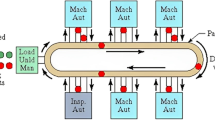Abstract
Strategic flexibility is considered as sustainable advantage in today’s global competitive environment. After exploring the link between the manufacturing objectives and their effect on the total industry performance in terms of profitability, product availability and capacity utilization, this study aims to quantify the strategic effect of applying five different strategies on the enterprise strategic flexibility capability. Using a system dynamic simulator that capture the strategic intent of the competing firms, results show that for industrial organizations to achieve high productivity, efficiency and maximum utilization rate they need to select from a wide range of strategic capabilities rather than concentrating on a single capability or process to match the requirements of the external environment with responsive rate that matches theindustry clock speed.
Access this chapter
Tax calculation will be finalised at checkout
Purchases are for personal use only
Preview
Unable to display preview. Download preview PDF.
Similar content being viewed by others
References
Wright, S., (1984): Manufacturing strategy: Defining the missing link, Strategic Management Journal, Vol. 5, No. 1, pp. 77-91.
Größler, A., Grübner, A., (2006): An empirical model of the relationships between manufacturing capabilities, International Journal of Operations & Production Management, Vol. 26, No. 5, pp. 458-485.
González-Benito, J., Suárez-González, I., (2009): A study of the role played by manufacturing strategic objectives and capabilities in understanding the relationship between porter's generic strategies and business performance, British Journal of Management,Vol., No.
Zhao, T., Tseng, C.L., (2003): Valuing flexibility in infrastructure expansion, Journal of infrastructure systems,Vol. 9, No., pp. 89.
Porter, M., (1981): The contributions of industrial organization to strategic management, Academy of Management Review,Vol. 6, No. 4, pp. 609-620.
Hashimoto, T., Sato, T., Nakatsuka, M., Fujimoto, M.): Evolutionary constructive approach for studying dynamic complex systems, Recent Advances in Modelling and Simulation, Vol., No., pp. 111–136.
Skinner, W., (1969): Manufacturing-missing link in corporate strategy, Harvard Business Review, Vol. 47, No. 3, pp. 136-145.
Teece, D., Pisano, G., Shuen, A., (1997): Dynamic capabilities and strategic management, Str. Mng. J.,Vol. 18, No. 7, pp. 509-533.
Lieberman, M.B., Montgomery, D.B., (1988): First mover advantages, Strategic Management Journal, Vol. 9, No. S1, pp. 41-58.
Forrester, J., (1994): System dynamics, systems thinking, and soft OR, System Dynamics Review, Vol. 10, No. 2 3, pp. 245-256.
Lindemann, U., Maurer, M., Braun, T., (2009): The procedure of structural complexity management, Structural Complexity Management, Vol., No., pp. 61-66.
Boyer, K.K., Lewis, M.W., (2002): Competitive priorities: Investigating the need for trade offs in operations strategy, Production and Operations Management, Vol. 11, No. 1, pp. 9–20.
Fred Sollish, C., John Semanik, C., (2011): Strategic Global Sourcing Best Practices, Wiley.
Author information
Authors and Affiliations
Editor information
Editors and Affiliations
Rights and permissions
Copyright information
© 2012 Springer-Verlag Berlin Heidelberg
About this paper
Cite this paper
Arafa, A., ElMaraghy, W.H. (2012). Quantifying the Effect of Enterprise Strategic Flexibility. In: ElMaraghy, H. (eds) Enabling Manufacturing Competitiveness and Economic Sustainability. Springer, Berlin, Heidelberg. https://doi.org/10.1007/978-3-642-23860-4_16
Download citation
DOI: https://doi.org/10.1007/978-3-642-23860-4_16
Published:
Publisher Name: Springer, Berlin, Heidelberg
Print ISBN: 978-3-642-23859-8
Online ISBN: 978-3-642-23860-4
eBook Packages: EngineeringEngineering (R0)




